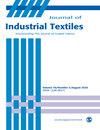Preparation and properties of thermal insulation felts for firefighting protective clothing
IF 2
4区 工程技术
Q1 MATERIALS SCIENCE, TEXTILES
引用次数: 0
Abstract
In this paper, preoxidized fibers, flame-retardant acrylic fibers and polyphenylene sulfide (PPS) fibers were chosen to prepare thermal insulation felts by the spunlaced process. The preparation of thermal insulation felts by single-component fibers, bicomponent fibers and multi-component fibers was studied. The breaking strength of the single fibers, flame retardancy, thermal conductivity, air permeability, thermal stability, shrinkage rate after washing, and the breaking strength of the thermal insulation felts were characterized. The results show that, for the single-component felts, preoxidized fiber felt had a longitudinal char length of only 35 mm, which was less than that of flame-retardant acrylic fiber felts and PPS felts. However, its longitudinal breaking strength was only 39.8 N. The bicomponent thermal insulation felt, blended with flame-retardant acrylic fibers and preoxidized fibers, had a higher breaking strength than the single-component felt, but it had char lengths greater than 100 mm after the vertical burning test. When the ratio of the multi-component insulation felts (preoxidized fibers, PPS fibers and flame-retardant acrylic fibers) was 35:60:5, the felt’s longitudinal char length measured 23 mm, which was less than that of the aramid felt 72 mm. This felt’s thermal conductivity was 0.0515 W/mK. It had an air permeability of 1995 mm/s, and the longitudinal dimensional shrinkage rate following the thermal stability test was only 1.1%. Multi-component thermal insulation felts are very important for the development of high-performance firefighting protective clothing.消防防护服隔热毡的制备和特性
本文选择了预氧化纤维、阻燃腈纶纤维和聚苯硫醚(PPS)纤维,通过纺粘法制备隔热毡。研究了单组分纤维、双组分纤维和多组分纤维制备隔热毡的情况。对单组分纤维的断裂强度、阻燃性、导热性、透气性、热稳定性、洗涤后收缩率以及隔热毡的断裂强度进行了表征。结果表明,就单组分毡而言,预氧化纤维毡的纵向炭化长度仅为 35 毫米,小于阻燃丙烯酸纤维毡和聚苯硫醚毡。由阻燃腈纶纤维和预氧化纤维混合而成的双组分隔热毡的断裂强度高于单组分隔热毡,但在垂直燃烧试验后,其纵向炭化长度大于 100 毫米。当多组分绝缘毡(预氧化纤维、PPS 纤维和阻燃腈纶纤维)的比例为 35:60:5 时,毡的纵向炭化长度为 23 毫米,小于芳纶毡的 72 毫米。这种毡的导热系数为 0.0515 W/mK。它的透气性为 1995 毫米/秒,热稳定性测试后的纵向尺寸收缩率仅为 1.1%。多组分隔热毡对于开发高性能消防防护服非常重要。
本文章由计算机程序翻译,如有差异,请以英文原文为准。
求助全文
约1分钟内获得全文
求助全文
来源期刊

Journal of Industrial Textiles
MATERIALS SCIENCE, TEXTILES-
CiteScore
5.30
自引率
18.80%
发文量
165
审稿时长
2.3 months
期刊介绍:
The Journal of Industrial Textiles is the only peer reviewed journal devoted exclusively to technology, processing, methodology, modelling and applications in technical textiles, nonwovens, coated and laminated fabrics, textile composites and nanofibers.
 求助内容:
求助内容: 应助结果提醒方式:
应助结果提醒方式:


